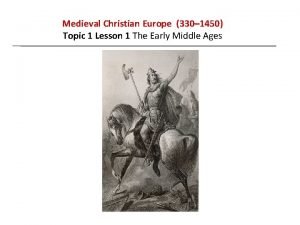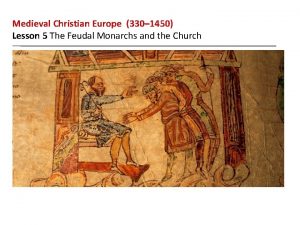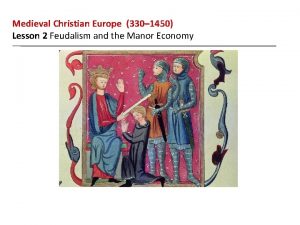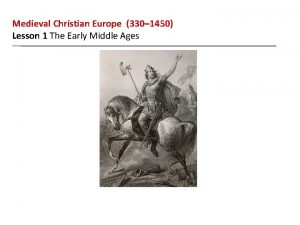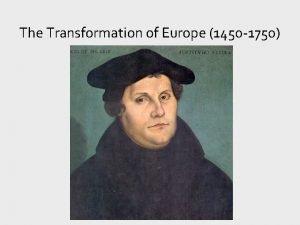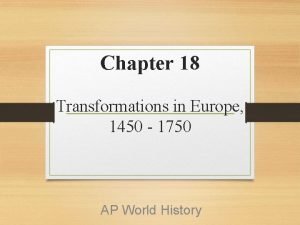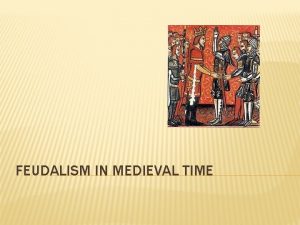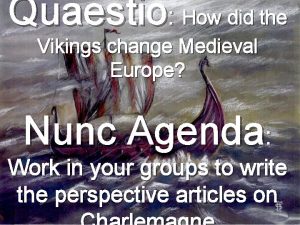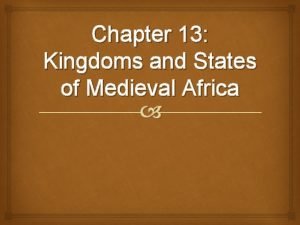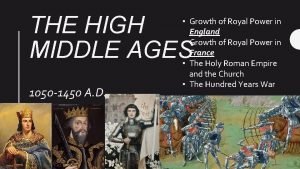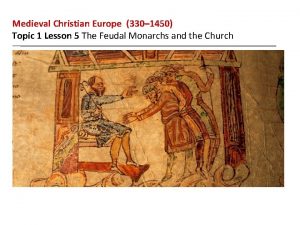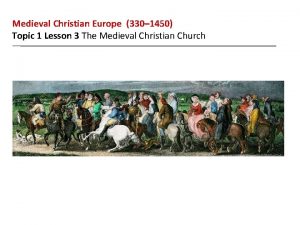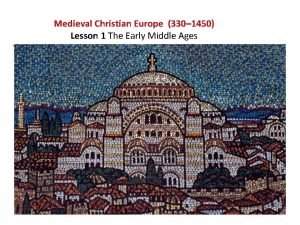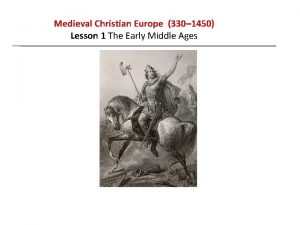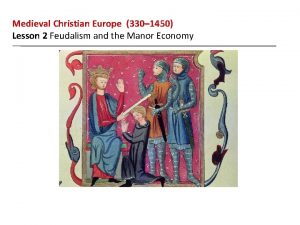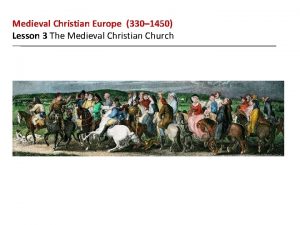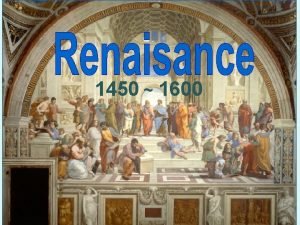Medieval Christian Europe 330 1450 Topic 1 Lesson












- Slides: 12

Medieval Christian Europe (330– 1450) Topic 1 Lesson 2 Feudalism and the Manor Economy

Medieval Christian Europe (330– 1450) Topic 1 Lesson 2 Feudalism and the Manor Economy Learning Objectives • Describe the development of the political and social system of feudalism. • Summarize the life of knights and nobles. • Analyze how the economic system of manorialism worked and how it affected peasants and nobles.

Feudalism Develops • In the face of invasions by Vikings, Muslims, and Magyars, kings and emperors were too weak to maintain law and order. • People needed protection for themselves, their homes, and their lands. • In response to this basic need for protection, a decentralized political and economic structure evolved, known as feudalism. • Feudalism was a loosely organized system of rule in which powerful local lords divided their landholdings among lesser lords. In exchange, these lesser lords, or vassals, pledged service and loyalty to the greater lord.

Feudalism Develops A monarch dubs a kneeling young man a knight. Two knights sponsor and stand by him in this French illustration from the late 1200 s.

Feudalism Develops Feudalism was based on mutual loyalty and obligations. Analyze Information What were some of feudalism’s advantages and disadvantages for medieval knights and peasants?

Nobles, Knights, and Warfare • • During the Middle Ages, warfare was constant. For medieval lords and vassals, it was a way of life. Rival lords battled constantly for power. Both greater and lesser nobles trained from boyhood for a future occupation as a knight, or mounted warrior.

Nobles, Knights, and Warfare The Life of a Knight • Starting at age 7 boys were sent to learn how to ride, fight, take care of arms and weapons • Upon finishing they were dubbed knights • They fought on horse back with swords, axes, and lances, and wore armor and shields • They competed in tournaments, mock battles, to keep skills sharp The Lives of Noblewomen • When men went off to fight, the women took charge. They supervised the household, managed vassals, and performed agricultural and medical tasks. • Her right to inheritance is severely limited at this time • Before she is married off she is expected to know how to spin and weave, and supervise servants.

Nobles, Knights, and Warfare The Code of Chivalry • Required knights to be brave, loyal, true to their word • They had to fight fairly, for example they had to let an opponent put on his armor • They had to treat enemies well and release them if the captured knight pledged to pay a ransom • Chivalry rules applied mostly to nobles • Chivalry also asked knights to protect the weak, like peasants and noble women. This will lead to putting women on a pedestal • This will lead troubadours to compose songs and poems that will lead to our idea of romantic love today

Nobles, Knights, and Warfare Castles and War Castle warfare in the Middle Ages was brutal. As shown in this illustration, battering rams, catapults, and fighters on ladders assaulted stone walls. Defenders shot arrows and poured hot oil on attackers.

Manorialism The heart of the medieval economy was the manor, or lord's estate. Most manors included one or more villages and the surrounding lands. Peasants, who made up the majority of the population in medieval society, lived and worked on the manor. An Economic System • The Lord provided justice and provided land protection and in return the peasants owed the lord labor and goods. The Mutual Obligations of Lords and Peasants • In exchange for labor the peasants from the lord received: land to farm for their own, protection from raid and warfare. This system will support Feudalism

Manorialism A Self-Sufficient World • In the manor almost everything needed was made there. There is no schooling and no knowledge of the outside world. The Life of a Peasant • Life is harsh for peasants. Hard labor all day. Food was black bread and vegetables. Very rarely is there meat to eat. Seasons and Celebrations • Spring, summer, and fall was work intensive. Winter was restful but food could run out. Celebrations include births and marriages, Easter and Christmas and other holidays.

Manorialism A bird’s-eye view of a typical medieval manor, which might include a manor house, a village church, a grain mill, storage barns, a blacksmith's shop, clustered peasant huts, and fields for crops and grazing.
 Topic 1 medieval christian europe
Topic 1 medieval christian europe Which actions did french kings take to increase royal power
Which actions did french kings take to increase royal power Feudal europe map
Feudal europe map Medieval kingdoms in europe lesson 1
Medieval kingdoms in europe lesson 1 Europe 1450
Europe 1450 Europe 1450
Europe 1450 Medieval hierarchy
Medieval hierarchy “how did the vikings change medieval europe?”
“how did the vikings change medieval europe?” Broad and specific topic examples
Broad and specific topic examples Tapic about internet
Tapic about internet Medieval africa geography
Medieval africa geography Mughal empire 1450 to 1750
Mughal empire 1450 to 1750 1450 ad
1450 ad
